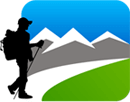Q1: Is it possible to get a visa upon arrival in Nepal?
Yes, entry visas upon arrival are available at Tribhuvan International Airport (TIA) in Kathmandu. When you are on the plane, the flight attendant will provide you with a visa form. Additionally, you can also obtain your visa pre-arrival at an embassy or consulate in your home country.
You'll need two passport-size photos and cash. The fees are USD 30 or equivalent foreign currency for 15 days, USD 50 for 30 days USD 125 for 90 days.
What is the difference between a Teahouse Trek and a Camping Trek?
- Teahouse Trek is staying in lodges (also called teahouses) along the trekking route managed by the local people. Meals will be taken at the lodges and in restaurants along the way. A teahouse trek requires no camping gear, but personal hiking gear and other personal items. A guide and porters accompany the journey.
- The camping trek is more elaborate than a Teahouse Trek as food, tents, and gear are carried by our porters and sometimes pack animals. Camp is set up each day by the porters and meals are prepared by our chef. A Camping Trek is comparatively more expensive than a Teahouse Trek.
Where can I change money?
Money-changing services are available at Kathmandu Airport, however, the best rates will be found in the city. We suggest that you change only a small amount at the airport if you would like to offer tips to the airport guide and driver.
Will somebody meet me on arrival at the airport?
Yes, our representative will be there to welcome you at the arrival gate and transfer you to your hotel. Our representative will be displaying a Good Vibe sign and your name.
Do I need to be physically fit to trek in Nepal?
Although there are no specific standards of physical fitness for trekking in Nepal, it certainly helps to be fit. The trails can be steep, and walking hours can be long, and certainly, any training you might be able to do beforehand will pay off on the trails. If you do not have experience in hiking, you could practice walking in your neighborhood or perhaps a nearby park. Each day in Nepal will offer differences including some long days and high-altitude hiking. We give an orientation on the specifics of altitude illness and our staff are trained to watch out for signs and symptoms. We have also arranged the tour schedule for proper adjustment to the trails and heights.
When is the best trekking season?
Most people generally arrive in the Autumn when views can be clearest, but Nepal is a varied land with trekking and other adventurous and leisure activities available year round. Spring is another favorite time for trekking when the famous Himalayan rhododendrons will be in bloom. The summer monsoons offer a chance to cool off or head north of the mountains to trek in the rain shadow. Winter is cooler, but still with good views and less crowds. Nepal is a destination for all seasons!
How long do we walk each day on the trek?
The quick answer is that treks have different gradings from easy to difficult. Easier treks will involve less daily hiking and will take a leisurely pace. Usually, we hike about five to six hours per day. However, there is no exact reply about the distance covered and time per day. The pace also will be determined by the physical fitness and interest of the guests.
What will the trails be like?
Most of the routes are along dirt trails and sometimes wide stone steps. The trails can involve steep climbs and descents through forests and rural landscapes. River crossings are usually on suspension bridges and shaded rest stops offer frequent chances to relax and take in the views.
What do I need to bring to Nepal?
Depending on your style and activity, we have the following recommendations, specifically geared towards trekkers but cover the basics for a broad range of activities: backpack/rucksack, hiking boots, plastic or aluminum water bottle, sleeping bag, cap, sunglasses, sunscreen/suncream, windproof and waterproof outer shell, warm inner jacket, thermal tops and bottoms, gloves, warm socks, a torch/flashlight, personal toiletries, universal adapter, camera with extra memory cards and re-chargeable batteries.
Do I need to buy special equipment?
If the above doesn't cover the necessities, then after arrival, extra items can be found at a reasonable price in Kathmandu.
Can I join a fixed departure as a single trekker?
Yes, normally we have single trekkers who join the group departures and comfortably fit in with the groups. Single trekkers share rooms or tents with other members of the same sex.



